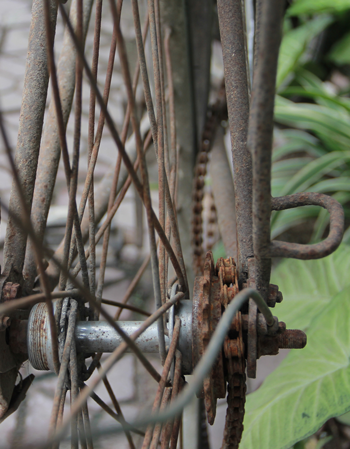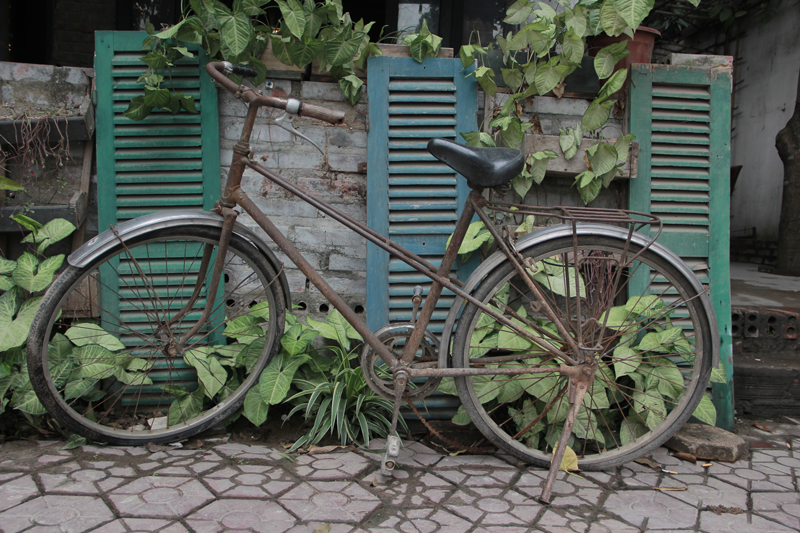By Uyen Nguyen
‘Did you seriously hang that hideous thing on the wall?’ says my aghast visitor after warming herself up with a cup of tea. Without tracing her line of sight, I know exactly what has shocked her.
My grandfather’s certificate of ownership for his first bicycle. 1975.
The yellowing and tattered piece of paper with a fading red stamp mark is probably the strangest thing you can find framed and hung. The peculiarity extends to its carefully chosen location: perfectly placed at eye-level on the wall facing my house’ entrance. Everything about it is perplexing, and even more so in Vietnam where a house façade is believed to reveal a lot about its owner’s interior.
About forty years back in Vietnam, bicycles were a symbol of opulence. Bikes by foreign brands like Peugeot, Aviac or Mercie cost an arm and a leg to get. Owning a bicycle was the dream of every young man. And, being taken around on one meant the most to every young Vietnamese girl. It is surely not a stretch to say that bicycles were the Ferraris of the 1970s. Their exorbitant prices earned bikes the title of ‘family treasures’, and prompted the need for government-issued certificates of ownership and even license plates.
During the war, it was not uncommon to see families with dozens of children. Who could blame the lack of family planning considering the emotional yearning of lonely wives when their husbands were sent off years at a time? Children were their only consolation and their reason to live.
Our family, too, was a fairly sizable one. Barely making ends meet, we were the ones who should not have owned a bicycle but did.
 Trained as a frontline paratrooper, my grandfather was sent on numerous missions throughout the entire Dien Bien Phu Revolution. That was until his fellow paratrooper landed on a bomb, detonating it and killing one-third of the troop that night and sending shrapnel flying into my grandfather’s legs. The mishap did not kill him, but it caused horrendous injury nonetheless.
Trained as a frontline paratrooper, my grandfather was sent on numerous missions throughout the entire Dien Bien Phu Revolution. That was until his fellow paratrooper landed on a bomb, detonating it and killing one-third of the troop that night and sending shrapnel flying into my grandfather’s legs. The mishap did not kill him, but it caused horrendous injury nonetheless.
I remember having played with his immense iron paratrooper helmet that must have easily weighed 5 kilograms and stared at the picture of him in his immaculate camouflage paratrooper uniform. He used to tell me stories about that fateful night while unconsciously tracing his fingers along the calves’ flesh engraved by surgical clamp marks and stitches.
The injury kept him in the hospital for half a year and earned him, somewhat ironically, a bicycle as government compensation. A simple brown Thong Nhat bicycle with a horizontal top tube and classic riser bars.
‘After the war, we lived on boiled cassava roots and watery porridges with nothing but salt,’ he recalled grimly.
But that ‘iron horse’, he used to say jokingly, saved our lives. Despite my grandfather’s disfigured legs, he rode thirty kilometres back and forth to get the daily quota of rice and other mediocre perishables. The Subsidy Economy period of 1975 is often cited as one of the most dramatic chapters in the history of Vietnam. Strict government control of the economy resulted in a tight distribution of standardized goods. Each person was entitled to only 300 grams of meat, 3 to 5 kilograms of vegetables, 1.5 litres of fish sauce and 10 kilograms of rice. The bicycle carried my grandfather and my family through the ravenous hunger of 1975.
The bike brought him to all corners looking for jobs. Its handlebars, stained with cement, sweat and blood, witnessed all the vicissitudes of his life. Its crank set, rusted and dusty, became his constant company on the interminable routes.
Thirty years later when we built our first house, my grandfather still never let go of his old pal. Every day he would take his retired friend out for a ride, carefully clean every part after he got back, and run his hands through the weathered spokes. This bike means so much more than a mere means of transport. It was a means of survival, a friend, and a faithful lifetime companion.
So yes.
‘Seriously,’ I reply. My visitor, still wide-eyed, hides a moment of perplexity and takes a sip of her empty cup.
Photo by Hai Tien

